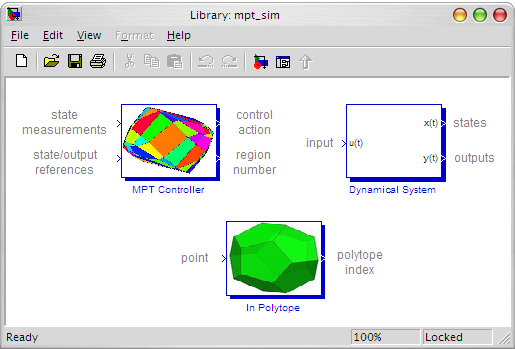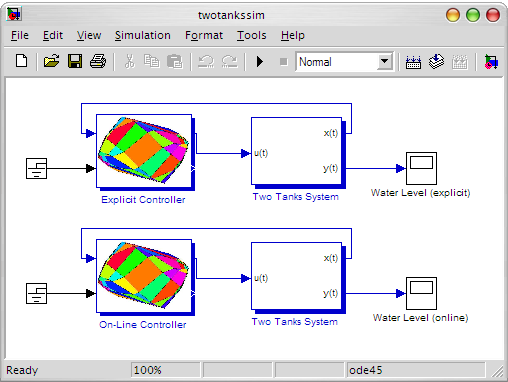MPT 2.0
MPT2 (alias MPT version 2.0) is the next major
relase of the Multi-Parameteric Toolbox after version 1.4.4 back in August 2004. Since
then, development has been focused on improvements in numerical robustness, runtime efficiency
of implemented algorithms, user interface and support of a broader class of solvers.
Brand new algorithm for optimal control of PWA systems
based on dynamical programming with PWA cost-to-go has been added as well, along with tools
which aim at reducing complexity of resulting explicit solutions. Explicit controllers
can be now exported to a standalone C-code, or compiled to executable form using the
Real Time Workshop.
New major features
Export of controllers to C-code
MPT 2.0 allows to export explicit controllers to a standalone C-code which
can then be linked together with your application. To export a controller, call
>> mpt_exportc(ctrl)
Have a look at mpt/examples/ccode/mpt_example.c on how to include
the controller into your application. Alternatively, executable code can be also
obtained using the Real Time Workshop from a Simulink model which includes one or
multiple instances of the MPT Controller block.
Improved Simulink interface
MPT 2.0 offers a comfortable Simulink library which allows to embed explicit and
on-line MPC controllers directly into your models. In addition, it provides blocks
for simulation of linear and hybrid systems with constraints and for assesment if a point
belongs to certain polytope.
To access the library,
run the following command on the command prompt:
>> mpt_sim
To get a flavour of how to connect the blocks, have a look at one of the following
demos:
>> ballandplatesim
>> turbocardemo
>> twotanksdemo
It is possible to directly compile any Simulink diagram which contains
one or more instances of the
MPT Controller block using the Real Time
Workshop to deploy the controllers to your target applications.
Verification of hybrid systems
Verification answers the following question:
Do states of a dynamical system (whose inputs
either belong to some set of admissible inputs, or whose inputs are
driven by an explicit control law) enter some set of "unsafe"
states in a given number of steps?.
The verification algorithm implemented in MPT 2.0 is based on the
reachability computation procedure and can be
called in two ways.
The first approach can be used to verify if a dynamical system can enter some
given set of "unsafe" states if the system inputs are assumed to belong to some
set of admissible inputs, i.e.
u(k) \in U:
>> canreach = mpt_verify(sysStruct, X0, Xf, N, U)
where sysStruct is a model of a linear or hybrid system,
X0 denotes set of initial states, Xf describes set
of "unsafe" states, N is the number of steps over which verification
should be performed and U is a set of admissible inputs. If the target
set Xf can be reached within of N steps, the function will
return true, otherwise false will be returned.
It is also possible to verify if a dynamical system can enter a set of "unsafe" states
if system inputs are driven by some explicit control law:
>> canreach = mpt_verify(ctrl, X0, Xf, N)
where ctrl is an explicit controller computed by MPT and the rest of
arguments has the same meaning as in the example above.
The verification procedure can be used in practive for instance to verify
safety and liveness properties of explicit control laws.
Improved Lyapunov analysis
MPT 2.0 brings a common interface to calculate large variety of Lyapunov function.
The following types of Lyapunov functions include:
- Quadratic Lyapunov functions
- Sum of Squares Lyapunov functions
- Piecewise-Affine Lyapunov functions
- Piecewise-Quadratic Lyapunov functions
- Piecewise-Polynomial Lyapunov functions
To calculate a Lyapunov function for a given explicit controller, this simple command
can be used:
>> ctrl_lyap = mpt_lyapunov(ctrl, lyaptype)
Here ctrl is a variable which describes an explicit controller and
lyaptype is a string parameter which chooses which type of Lyapunov function
to compute.
Graphical user interface
MPT now features a rich Graphical User Interface (GUI) for modeling of constrained linear and
hybrid systems, controller computation and post-analysis. You can see it live in action in
our flash
live demos section, or watch some
screenshots. Type
>> mpt_studio
on the command line to start the GUI.
Computation of on-line MPC controllers
MPT can now also design on-line MPC controllers in addition to explicit control laws. Just define
your dynamical system and properties of the optimization problem and call
>> controller = mpt_control(sysStruct, probStruct, 'on-line')
to compute an on-line controller. The controller can then be used for simulations in exactly
the same way as explicit controllers are. For instance, you can plug an on-line controller directly
into the new MPT Simulink interface and perform simulations there in the usual manner.
Intuitive modeling of hybrid systems
MPT can now design controllers for hybrid systems generated from
HYSDEL models. HYSDEL (HYbrid Systems DEscription Language) is a language for easy modeling of
hybrid systems described by interconnections of linear dynamic systems, automata,
if-then-else and propositional logic rules. To transform a HYSDEL model into a model suitable
for MPT, simply call:
>> sysStruct = mpt_sys('myhysdelfile')
where myhysdelfile is the name of the file which contains your model.
Dynamical models can also be imported from state-space objects (ss),
transfer function objects (tf), system identification toolbox objects (idss)
and MPC toolbox objects (mpc). To convert a model from one of these objects, call
>> sysStruct = mpt_sys(myvar)
where myvar is a variabled of one of the above mentioned types.
Complexity reduction
Complexity of explicit solutions was always an important issue. There are two levels of complexity
involved in multi-parametric solutions to optimal control problems:
- Runtime complexity
- Complexity of the resulting solution in terms of the number of regions
Runtime complexity is important during
the computation of the solution, while the second level is vital for
on-line implementation of explicit controllers in real life. Clearly, the higher the number of regions
the longer it takes to identify a proper control law and also the more memory is needed to store all
necessary regions along with the associated control laws. Therefore there is a clear need of
simple controllers in terms of number of regions. Although this can be achived by applying one of
the low-complexity schemes MPT offers, these controllers do not guarantee optimal performance.
If the controller is required to provide optimal control action, complexity can only be reduced by
post-processing. MPT2 now allows to achieve this goal by
simplifying the resulting controller while maintaining the same performance the original
controller gives. This is achived by merging regions which have the same control law into larger chunks.
Two levels of simplifications can be used:
- Optimal merging
- Greedy merging
Optimal merging gives least number of regions one could possible get, while greedy merging is based on
a randomized procedure which checks which regions can be merged. Differences between these two methods
are in runtime and complexity of the simplified solutions. The greedy merging algorithm is much faster but optimal
merging gives the least number of regions one can possibly get. So the choice is up to you. Give the
function a try by calling
>> simple_controller = mpt_simplify(controller)
Consult help mpt_simplify for how to switch from greedy merging (which is used by default) to
optimal merging.
Efficiency of algorithms
Big progress has been achieved in improving runtime efficiency of (almost all) algorihtms provided by MPT.
First, a brand new technique for computing solutions to Constrained Finite-Time Optimal Control (CFTOC) problems for
Piecewise-Affine (PWA) systems is now available. This algorithm, developed by
Miroslav Baric et al.,
is based on a Dynamic Programming approach with Piecewise-Affine cost-to-go expressions. As can be seen from the
table below, this algorithm is
faster by a factor of 2-20 (depending on the problem) than the original
implementation of the CFTOC algorithm. Secondly, the complete MPT code has been massively optimized
for runtime speed, which gives the
new version an additional edge over the old release.
| Problem setup |
Runtime MPT 1.4.4 |
Runtime MPT 2.0 |
Improvement |
Problem 1 |
468.0 secs | 180.0 secs |
260 % |
Problem 2 |
402.1 secs | 226.0 secs |
178 % |
Problem 3 |
1817.0 secs | 154.7 secs |
1175 % |
Problem 4 |
22.7 secs | 9.8 secs |
232 % |
Problem 1 |
Finite time solution for a 2D PWA system (opt_sincos; probStruct.N=11) |
Problem 2 |
Minimum-time solution for a 3D PWA system (pwa3d; probStruct.subopt_lev=1) |
Problem 3 |
Finite time solution for a 3D PWA system (pwa3d; probStruct.subopt_lev=0; probStruct.norm=1; probStruct.N=4) |
Problem 4 |
Finite-time solution for a 2D LTI system
(Double_Integrator; probStruct.norm=1; probStruct.N=7) |
Computation of reachable sets
N-step reachable sets, i.e. sets of states which are reachable from a given set of intitial conditions in
N steps,
can now be computed using mpt_reachSets. Sets can be calculated
either for a dynamical system whose inputs are assumed to belong to some bounded set
U0 using
>> sets = mpt_reachSets(sysStruct, X0, U0, N)
or for an explicit controller
>> sets = mpt_reachSets(ctrl, X0, N)
In the latter case, the system inputs are assumed to be driven by an explicit controller ctrl.
For more information discuss help mpt_reachSets.
Improved numerical robustness
It is a known fact that different solvers tend to give slightly different solutions in some tricky cases.
MPT2 therefore introduces extensive error checking while solving certain
linear and quadratic programs in order to avoid any problems resulting from a buggy behavior of external
solvers. If a problem is detected, the given LP (QP) will be automatically solved again with a different
solver in order to get a feasible solution. Our tests have shown that this rescue procedure often
helps to obtain a solution in cases where the old release failed.
Support for many solvers
MPT2 comes with an extended support for LP, QP, MILP and MIQP solvers. Besides
the already supported solvers (CPLEX, NAG, CDD, GLPK, QSopt), we have added support for
XPRESS, MOSEK, OOQP, CLP and
bintprog. Depending on the problem you are solving,
fastest and most reliable solvers will be choosen automatically. If one solver fails to give a proper solution due
to numerical problems, another available solver will be tried automatically as described in the
numerical robustness section.
Other improvements


